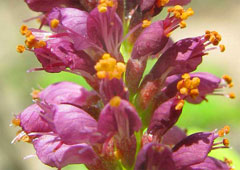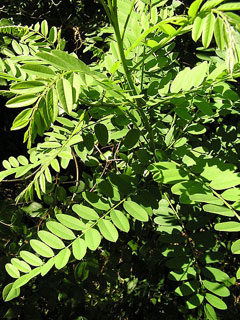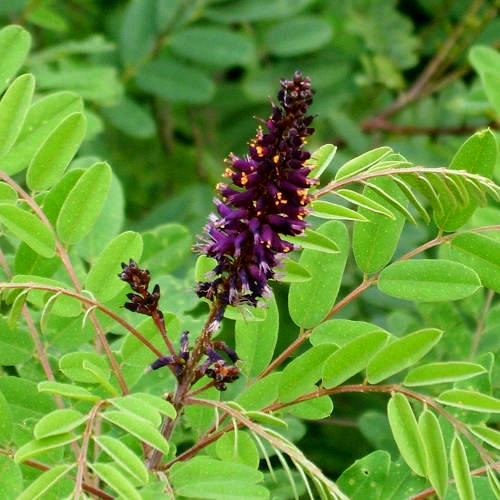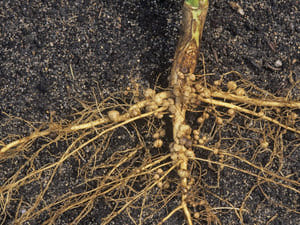Amorpha fruticosa - L.
| Common Name | False Indigo, False indigo bush | |||||
| Family | Fabaceae or Leguminosae | |||||
| USDA hardiness | 4-8 | |||||
| Known Hazards |  The plant is said to contain alkaloids and be poisonous to livestock[274]. The plant is said to contain alkaloids and be poisonous to livestock[274]. |
|||||
| Habitats | River banks, rich moist thickets etc[43, 184]. Grows chiefly in limestone soils[274]. | |||||
| Range | Southern N. America. Locally naturalized in S. and C. Europe[50]. | |||||
| Edibility Rating |      (1 of 5) (1 of 5) |
|||||
| Other Uses |      (3 of 5) (3 of 5) |
|||||
| Weed Potential | Yes | |||||
| Medicinal Rating |      (0 of 5) (0 of 5) |
|||||
| Care |
|
 |
|
|
http://commons.wikimedia.org/wiki/User:Gromhelm
|
|
 |
|
| http://commons.wikimedia.org/wiki/User:Gromhelm |
Summary
Amorpha fruticosa is a deciduous nitrogen fixing shrub in the legume family. Found wild in most of the contiguous United States, southeastern Canada, and northern Mexico and introduced to Europe. Asia and other continents. It is often cultivated as an ornamental plant. It has minor edible use and some additional uses including: Bedding; Dye; Insecticide; Oil; Repellent; Shelterbelt; and Soil stabilization. Common names, including desert false indigo, false indigo-bush, and bastard indigobush.
Physical Characteristics


Amorpha fruticosa is a deciduous Shrub growing to 4.5 m (14ft 9in) at a medium rate.
It is hardy to zone (UK) 4. It is in flower in July. The species is hermaphrodite (has both male and female organs).
It can fix Nitrogen.
Suitable for: light (sandy) and medium (loamy) soils, prefers well-drained soil and can grow in nutritionally poor soil. Suitable pH: acid, neutral and basic (alkaline) soils. It can grow in semi-shade (light woodland) or no shade. It prefers dry or moist soil and can tolerate drought. The plant can tolerates strong winds but not maritime exposure.
Synonyms
Habitats
Woodland Garden Sunny Edge; Dappled Shade;
Edible Uses
Edible Parts: Oil.
Edible Uses: Condiment; Oil.
The crushed fruit is used as a condiment[105, 177, 183].
Medicinal Uses
Plants For A Future can not take any responsibility for any adverse effects from the use of plants. Always seek advice from a professional before using a plant medicinally.
None known
Other Uses
Bedding; Dye; Insecticide; Oil; Repellent; Shelterbelt; Soil stabilization.
Plants have an extensive root system and are also fairly wind tolerant, they can be planted as a windbreak and also to prevent soil erosion[200]. Resinous pustules on the plant contain 'amorpha', a contact and stomachic insecticide that also acts as an insect repellent[57, 200]. The stems are used as bedding[61]. The plant contains some indigo pigment and can be used to make a blue dye[169]. Unfortunately, the pigment is only present in very small quantities, there is not enough to harvest commercially[169].
Cultivation details
Agroforestry Services: Alley crop; Agroforestry Services: Contour hedgerow; Agroforestry Services: Nitrogen; Agroforestry Services: Windbreak; Fodder: Bank; Industrial Crop: Pesticide; Management: Coppice; Minor Global Crop.
Prefers a light well-drained sandy soil in sun or light shade[184, 200]. Plants are fairly wind-resistant[200]. A very hardy plant, tolerating temperatures down to about -25c[184, 200]. A polymorphic species, there are many named forms[43]. The flowers have a vanilla perfume[245]. Plants resent root disturbance, they should be planted out into their final positions whilst small[133]. Trees only ripen their seed in fine autumns[80]. Plants are said to be immune to insect pests[200]. This species has a symbiotic relationship with certain soil bacteria, these bacteria form nodules on the roots and fix atmospheric nitrogen. Some of this nitrogen is utilized by the growing plant but some can also be used by other plants growing nearby[200].
Propagation
Seed - pre-soak for 12 hours in warm water and then sow early spring in a greenhouse[78, 133]. The seed usually germinates in 1 - 2 months at 20°c[133]. When large enough to handle, prick the seedlings out into individual pots and grow them on in the greenhouse for their first winter. Plant them out in late spring or early summer, after the last expected frosts. Cuttings of half-ripe wood, June/July in a frame. High percentage[78]. Cuttings of mature wood of the current seasons growth, autumn, in a sheltered position outdoors. Takes 12 months[78]. Suckers in spring just before new growth begins[200]. Layering in spring .

